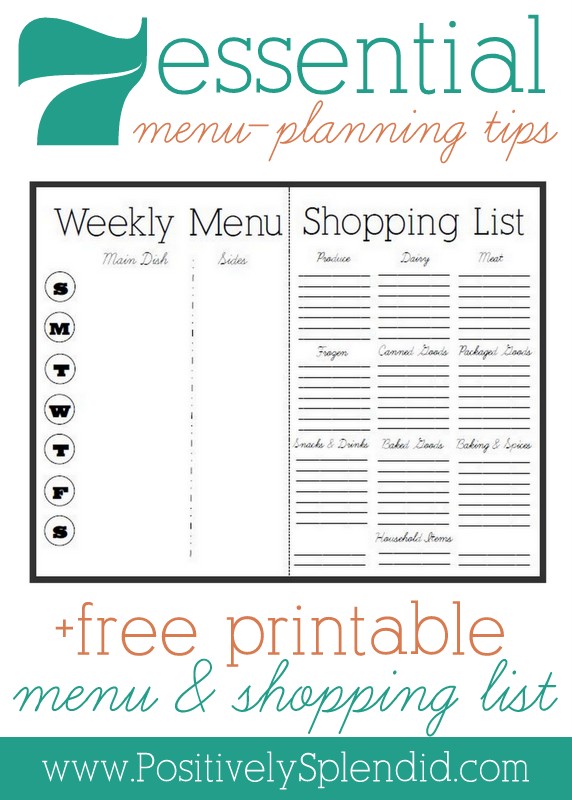
A menu that promotes healthy eating can seem overwhelming, but there are a few things you can do. First, consider substituting solid fats with liquid ones. You can also choose olive oil over butter. This is also healthier. Make sure you choose whole grains and not white flour or refined sugar. Introduce a new vegetable every week. You should introduce a different variety of vegetable each month to encourage your children to eat more vegetables.
Talk with your family to discuss what you'd prefer for your meals and the changes you'd make. It is common for children to follow their parents' lead, so make sure you are setting good examples. You should set clear goals and follow them. Your family should be supportive of your lifestyle plan and help you avoid common pitfalls. By creating a menu together, you can get your family on board and be a role model.

Encourage your children to participate in the preparation of meals. Encourage your children to prepare meals at home, especially for family meals. Encourage kids to take ownership of their meals and eat a variety of food. Make sure you offer more than just food rewards to increase motivation. If you're raising younger children, consider using a reward system. If they eat a particular food, they can earn extra screen time or an allowance.
While most people don't realize it, eating meals together with your family can be beneficial for everyone. It helps to keep your family connected, and helps them stay motivated and engaged. Studies have shown that healthy eating habits are more common in children who eat together with their parents. It is good for their physical and mental health as well as their self-esteem. You and your family can promote a healthy diet, and a positive lifestyle by following these tips.
In order to make your family meals more healthy, add more vegetables. While it may not be possible to include all of the recommended servings of vegetables at every meal, it is important to incorporate fruits and vegetables at each meal. It is not necessary to make a large meal for your entire family. It is easy to increase your family's daily intake by including a variety of vegetables in your meals. The more you can incorporate into your meals, the better!

Don't forget to include whole grains in your meal planning. Healthy substitutions can be made by substituting whole grains for refined grains. Half of the grains in your family should be whole grains. This includes whole wheat bread, brown rice, and pasta. You can also substitute other whole grains with healthy dips and snacks, such as quinoa, whole wheat couscouscous, bulgur, and oats.
FAQ
Is being cold good for your immune system.
Cold causes a decrease in immune system strength. This is because white blood cells are less effective at fighting infection. However, being cold also makes you feel better because your body releases endorphins into your brain which reduce pain.
Exercise: Good and bad for immunity?
Exercise is good to your immune system. Your body makes white blood cells that fight infections when you exercise. You also get rid of toxins from your body. Exercise helps to prevent heart disease and cancer. Exercise also helps to reduce stress levels.
But, too much exercise can lead to a weakening of your immune system. Exercising too hard can make your muscles sore. This can cause inflammation and swelling. Your body will then produce more antibodies in order to fight infections. The problem is that these extra antibodies can cause allergies and autoimmune disorders.
So, don't overdo it!
What is the difference of a virus from a bacteria?
A virus, a microscopic organism, is incapable of reproducing outside its host cell. A bacterium, a single-celled organism, reproduces by splitting into two. Viruses are small, around 20 nanometers in size. Bacteria are much larger, at 1 micron.
Viruses are spread via contact with infected bodily liquids such as urine, saliva, semen and vaginal secretions. Bacteria are usually spread through direct contact with contaminated objects or surfaces.
Viruses can get into our bodies through cuts and scrapes on the skin, bites, and other injuries. They can also be transmitted through the eyes, nose, mouth, ears, rectum, and anus.
Bacteria can enter our bodies through wounds, cuts, scrapes, burns, insect stings, or other breaks in our skin. They may also come into our bodies through food, water, air, soil, dust, or animals.
Both bacteria as well as viruses can cause illness. But viruses do not have the ability to multiply within their hosts. They only cause disease when they infect living tissue.
Bacteria can grow in their hosts and cause disease. They can spread to other parts of our bodies. To kill them, we must use antibiotics.
Do I need calories to count?
Perhaps you are wondering what the best diet is for you. or "is counting calories necessary?" The answer to this question depends on many factors, including your current health, your personal goals and preferences, as well as your overall lifestyle.
The Best Diet For Me - Which One Is Right For You?
The best diet depends on me, my health, my goals, my preferences and my overall lifestyle. There are many diets available, some good and others not so good. Some diets work well for some people and others do not. So what should I do? How do I make a good decision?
This article aims at answering these questions. The article starts by introducing the many types of diets currently available. Then, the pros and cons of each type of diet are discussed. Then, we will discuss which diet is the best.
Let's start by taking a look at the various types of diets.
Diet Types
There are three main types: low-fat, high-protein, or ketogenic. Let's talk about them briefly.
Low Fat Diets
A low fat diet is a diet that restricts the amount of fats consumed. This is achieved through reducing intakes of saturated fats (butter and cream cheese, for example). and replacing them with unsaturated fats (olive oil, avocados, etc.). People who are looking to lose weight quickly and easily will benefit from a low-fat diet. This diet can cause constipation, heartburn, and stomach problems. A person may also experience vitamin deficiencies if they don't get enough vitamins.
High Protein Diets
High protein diets restrict carbohydrates in favor of proteins. These diets often have higher levels of protein than most other diets. These diets are meant to increase muscle mass, and burn more calories. Unfortunately, they can't provide adequate nutrition for those who eat regularly. They are not suitable for all people because they can be restrictive.
Ketogenic Diets
Ketogenic diets can also be known as keto diets. They are high on fat but low in carbs and proteins. These foods are popular among athletes and bodybuilders as they allow them to train harder, longer and without becoming tired. However, they must be used with caution to avoid nausea, headaches and fatigue.
How does an antibiotic work?
Antibiotics can be used to kill bacteria. Antibiotics are used to treat bacterial infections. There are many options for antibiotics. Some can be taken orally while others are injected. Others are topically applied.
People who have been infected with certain germs may need antibiotics. To prevent shingles, an oral antibiotic may be prescribed to someone who has had chicken pox. Or, if someone has had strep throat, he or she might receive an injection of penicillin to help prevent pneumonia.
Doctors should prescribe antibiotics to children. Children are at greater risk than adults for developing serious side effects from taking antibiotics.
Diarrhea is the most common side effect from antibiotics. Other side effects that could occur include nausea, vomiting and dizziness. These side effects usually disappear once treatment has ended.
Statistics
- Extra virgin olive oil may benefit heart health, as people who consume it have a lower risk for dying from heart attacks and strokes according to some evidence (57Trusted Source (healthline.com)
- In both adults and children, the intake of free sugars should be reduced to less than 10% of total energy intake. (who.int)
- WHO recommends consuming less than 5% of total energy intake for additional health benefits. (who.int)
- According to the Physical Activity Guidelines for Americans, we should strive for at least 150 minutes of moderate intensity activity each week (54Trusted Source Smoking, harmful use of drugs, and alcohol abuse can all seriously negatively affect your health. (healthline.com)
External Links
How To
What does the "vitamins” word mean?
Vitamins are organic compounds found naturally in food. Vitamins are necessary for us to absorb nutrients in the foods we consume. Vitamins cannot come from the body so food must provide them.
There are two types vitamins: water soluble or fat soluble. Water-soluble vitamins dissolve quickly in water. You can find vitamin C,B1 or thiamine, B2 or riboflavin and B3 or niacin, B3/niacin, B6/pyridoxine, folic Acid, biotin and pantothenic Acid as examples. Fat-soluble vitamins can be stored in the liver or in fatty tissue. These include vitamin D, E and K, as well as beta carotene.
Vitamins are classified based on their biological activity. There are eight major vitamin groups:
-
A - Essential for healthy growth and health maintenance.
-
C is important for nerve function and energy production.
-
D - essential for healthy bones, teeth, and gums.
-
E is required for good vision and reproduction.
-
K - Required for healthy nerves and muscles.
-
P - Vital for strong bones and teeth.
-
Q - Aids digestion and iron absorption
-
R is required for the production of red blood cells.
The recommended daily allowance (RDA), for vitamins, varies depending upon age, gender, or physical condition. The U.S. Food and Drug Administration has established the RDA values.
For example, the RDA for vitamin A is 400 micrograms per dayfor adults 19 years or older. Pregnant mothers need 600 micrograms per days because it is vital for the development and growth of their baby. Children ages 1-8 require 900 micrograms per day. For infants younger than one year, 700 micrograms are required daily. However, this number drops to 500 micrograms each day for children aged 9-12 months.
Children between the ages 1--18 years old who are overweight or obese require 800 micrograms per Day, while those who are overweight or obese need 1000 micrograms. To meet their nutritional needs, children underweight and obese require 1200 micrograms a day.
Children ages 4-8 years who have been diagnosed with anemia need 2200 micrograms per day of vitamin C.
2000 micrograms are required daily for good health in adults over 50. Women who are pregnant or breastfeeding need 3000 micrograms per day due to increased nutrient requirements.
1500 micrograms are required daily by adults over 70 because they lose approximately 10% of their muscle each decade.
Women who have been pregnant or are lactating require more than the RDA. Pregnant women require 4000 micrograms daily during pregnancy, and 2500 micrograms every day after birth. Breastfeeding mothers need 5000 micrograms per day when breast milk is being produced.